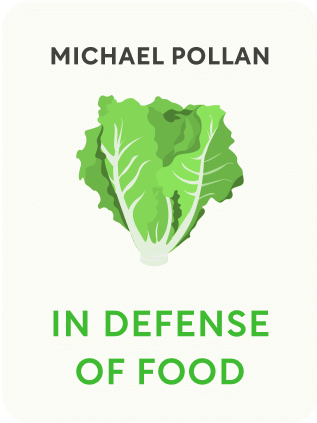

This article is an excerpt from the Shortform book guide to "In Defense of Food" by Michael Pollan. Shortform has the world's best summaries and analyses of books you should be reading.
Like this article? Sign up for a free trial here .
How has the industrialization of food production changed the way we eat? What five shifts in nutrition did it cause?
According to Michael Pollan, the author of In Defense of Food, the industrialization of food production has compromised our relationship with food in many profound ways. Specifically, industrializing food production has led to five major shifts in nutrition that are responsible for most food-related diseases.
Keep reading to learn about the consequences resulting from the industrialization of food production, according to Michael Pollan.
Repercussions of Industrialized Food Production
The industrialization of food production is a new problem for humans. In the past, the relationship between humans and food was the food chain and occurred in every aspect of nature. Organisms along this chain tended to adapt to or with one another to survive.
For example, cow’s milk used to make people physically sick. Then, five thousand years ago, milk farmers and the surrounding community started to evolve. A mutation of the gene that promotes the enzyme needed to digest milk spread through the population. The milk gave the herders the ability to have and raise more children, which increased the spread of the gene. Likewise, the larger population and improvements to health allowed for better care of the cows, which improved their lives and allowed more reproduction.
When one aspect of the food chain is disrupted, it disrupts the rest of the chain. If the soil is unhealthy, the grass growing from it will be unhealthy, and the cows that eat the grass will be unhealthy, and so on. Therefore, the health of humans is greatly dependent on the health of the food chain.
In the past, the familiar relationship between humans and their food guided decisions on what to eat. For example, you could tell by looking at a fruit whether it was ripe or spoiled. What the industrialization of food did was create food that looks like food but isn’t. The fake food doesn’t spoil. This makes it impossible to visually judge whether the food is good or bad.
You can’t see chemicals or nutrients. And because our relationship with processed foods is shallow, instinct can’t play a part. Further, the way the whole food is processed creates confusion in the body.
Corn, for example, breaks down in the body as sugar, but the fiber in it mediates the pace. The body is prepared to accept this process and absorb the sugars because of its long relationship with corn. High-fructose corn syrup, however, is a different story. The body has no idea what to do with it because it’s an artificial compound. In time, our bodies will learn how to adapt, but for the moment, that is not the case.
This example shows just how far removed we’ve become from our natural relationships with food in the Western diet. How did this relationship become so rocky? Five shifts in nutrition are responsible for the movement away from nature and toward the modern diet.
Shift #1: The Rise of Refined Foods
The advent of refined carbohydrates is one of the most fundamental changes in the history of food and one of the most damaging to the human body. Refined grains, rice, and sugar have many benefits, but none of them involve health. In fact, refined foods are almost empty of nutritional value without fortification and lead to massive influxes of glucose and fructose in the body. So why do we eat so much of them? Part of the answer is history.
Grains
Before the Industrial Revolution, grains were stone ground in small batches by mills run on water power. The flour was yellowish and pungent. The grinders could remove the bran from wheat but not the germ. When the germ was crushed, it released an oil, which created the color and smell. The oil also oxidized quickly, making the shelf life of the flour short.
When steel, iron, and porcelain rollers were invented, they were able to remove the germ and grind the rest into a fine white powder. This flour was more appealing and had a long shelf life without the oil. Because the rollers could be operated by steam engines, manufacturers could now grind flour year round and ship it distances without it spoiling.
The problem is that the germ in wheat holds most of the nutritional value, including B vitamins, protein, carotenes, and omega-3 fatty acids. Without the germ, refined flour is basically nutrient-free. The flour breaks down into glucose, which overwhelms the body’s insulin processes without the mitigating nutrients. During this time, corn and rice were undergoing their own processes to strip the nutrients and make them more sustainable.
What followed were deficiencies of certain nutrients that led to diseases, such as beriberi (vitamin B deficiency). In the 1930s, scientists figured out the connection between refined foods and disease. Mills started adding B vitamins back into the refined grain. In 1996, scientists discovered that Americans were low on folic acid, so that was also added back into refined grains. These steps helped with deficiency diseases, but they did nothing to stop the killer diseases spreading through the population.
Scientists noticed that people who ate whole grains were healthier, and the mission to identify which nutrients caused it started. But even when these nutrients were supplemented by other sources, people were still not seeing the same results as those who ate the actual whole grain. They reasoned that some internal synergistic relationship was causing the benefit.
This discovery should have been the end of the discussion. But processed foods are more marketable than whole foods. So the food industry surged on in its assertion that fortifying foods with nutrients was just as good as eating the whole food.
Sugar
Sugar can be considered the pinnacle of refined carbohydrates. Refined sugar was introduced around the same time refined flours were taking off. By the end of the 19th century, one-sixth of all calories came from sugar. Fructose is the sweet element of sugar and is typically only seen in nature in ripe fruits. These fruits also include fiber that, like with corn, slows the release and intake of the fructose and includes other essential nutrients.
Refined sugar, like high-fructose corn syrup, is basically a mainline of fructose to the system. With sugar being added to the diet, people now had an influx of fructose to go along with the influx of glucose from refined flour. Today, 20% of total calories come from sugar and 40% from mostly refined grains, which means the American diet is approximately 50% sugar in one form or another. Another way to think about it is that 50% of the diet is pure energy and nothing else.
Metabolic syndrome and Type-2 diabetes are the results of this influx of sugar, as the body struggles to produce enough insulin to respond. Another health issue related to high sugar intake is obesity. Fiber not only mitigates the quick release of sugar, it also helps you feel satiated. When fiber is removed, you may still feel hungry even after eating a large meal of refined carbohydrates. Also, the quick release of sugar causes insulin production to spike then crash, which makes the body believe it needs to eat again. Both of these situations can lead to overeating.
Shift #2: The Simplification of Food
The industrialization of food is founded in the concept of simplification. When we alter both soil and food to simplify natural processes, we create distance between humans and the natural food chain. We also create many disadvantages for the human body.
Soil
Remember Liebig’s discovery of the three basic elements—nitrogen, phosphorus, and potassium—needed in soil to grow food? That discovery, coupled with the ability to transform fossil fuels into nitrogen fertilizer after WWII, reshaped how food was grown throughout America.
It’s true that plants can thrive with only these chemicals, but it’s also true that the ability to thrive has little to do with nutritional value. Chemical fertilizers make plants grow faster. But when plants grow at a fast rate, there is less gestation time, meaning less time to absorb nutrients from the soil. Also, because the big three elements are readily available to the plants, their roots don’t dig as deep into the soil to find nutrients. Shallow roots means a lack of access to deep soil minerals.
The result is plants with little nutrient value, which makes them more susceptible to pests and disease. Since chemical fertilizers were introduced in 1950, the nutritional value of fresh fruits and vegetables, as tracked by the USDA, has deteriorated.
Food
Simplifying food means everything from making foods less perishable to removing less-desirable species from the market. Despite the seemingly endless variety of food available today, the base ingredients are made up of only a few food species chosen for their high-yield value and those easily harvested and manipulated.
Where an Iowa farm once raised several types of livestock and a variety of fruits and vegetables, now they almost all exclusively raise corn and soybeans. This move is championed by government subsidies for corn and soybean farmers.
What’s so special about corn and soybeans? They both are proficient at transforming sunlight and chemical fertilizers into macronutrients (carbohydrates for corn and fat and protein for soybeans). They are cheap to grow and easy to manipulate into other processed foods. For instance, many people believe they don’t eat a lot of corn or soy, but 75% of all vegetable oils are soy-based, and 50% of all sweeteners are corn-based. In fact, 800 of the total daily calories come from a combination of corn (550) and soy (250). When you add 750 calories from wheat and 90 from rice, that is two-thirds of the total daily caloric intake from four species.
The problem is that humans are omnivores. Ss such, we require approximately 50 to 100 different nutrient properties to function properly. When food species varied, we were getting different nutrients from hundreds to thousands of sources, which created a complex nutrient landscape. With only four species making up most of the food, and many of those stripped of their nutrient value, how likely is it that you’re getting everything you need?
Shift #3: When More Outweighs Value
The food industry’s focus on quantity over quality has stripped most of the nutritional value from whole foods on the market today. The result of efforts to simplify how food is grown, make food more durable, and reduce the number of food species is a food inflation in the American diet. A food inflation is when more food must be eaten to gain the same level of nutrients that less food provided in the past.
According to the USDA studies, since the mid-20th century, vitamin C has decreased by 20%, iron by 15%, riboflavin by 38%, and calcium by 16% in produce. What this means is you would need to eat three apples today to get the same amount of iron as one apple in 1940.
One way industry promotes quantity over quality is through genetics. Many manufacturers breed certain types of food sources for high yields, such as seeds and certain types of livestock. Wheat is bred to increase its yield output, which has nearly tripled over the last century. Holstein cows have been bred since 1950 to produce more milk. But when you breed for a certain outcome, other elements go by the wayside. In the case of food, it’s nutrients. Today’s wheat contains 28% less iron than before, and milk from Holstein cows has less butter fat and fewer nutrients than milk from other cow species.
Another way quantity has pushed quality out of the way is the industry focus on foods high in calories and low in price. After a surge in food prices in the mid-70s caused housewives to revolt, the U.S. government created new agriculture policies to ensure the availability of cheap food. The subsidies for corn and soybean farmers are an example of these policies. Farmers were encouraged to grow large amounts of food in small amounts of time.
The policies worked. Food production increased and prices decreased. But this increase caused another increase: 300 added calories per day to the American diet since 1985. A fourth of those calories are from added sugars, another fourth from added fats, and 46% from mostly refined grains. That leaves only 8% of the daily caloric intake from fruits and vegetables. In fact, adults only eat 32% and children 20% of the recommended daily servings of fruits and vegetables.
This dietary focus on more over value has created a strange phenomenon in society—overfed but undernourished citizens. Old deficiency diseases are cropping back up, but now they’re being seen in obese people, especially children. Deficiency breaks down DNA, which can lead to cancer.
Shift #4: The Downfall of Shifting from Greens to Seeds
Our reliance on a handful of species means a reliance on durable seeds with long shelf lives, from which corn, soybeans, wheat, and rice all derive. This shift away from leafy vegetables brought a shift away from micronutrients toward macronutrients. The amount of macronutrients found in most processed foods leads to an overabundance in our systems, which leads to obesity and other killer diseases. However, what may be more damaging is the lack of certain vital micronutrients, namely omega-3 fatty acids. Omega-3 and omega-6 fatty acids are both naturally occurring in different food sources, but they differ greatly in structure and mechanism in the body.
Omega-3s vs. Omega-6s
Omega-3 fatty acids are found in plant leaves and may be the most essential nutrient of all. They are important for neurological development and processing, vision, cell wall permeability, glucose metabolism, and reductions in the inflammatory response. Omega-3s are swift and malleable, which also make them more perishable and not suitable for long-term storage.
The food industry does what it can to remove omega-3s from products to increase their shelf life. Breeders look for crops low in omega-3s, and nutritionism has helped eliminate omega-3s from the diet through its push of seed oils and hydrogenated fats.
Omega-6 fatty acids, on the other hand, are found in durable seeds. These fatty acids are dense and slow, which make them more suitable for storage. They promote the storage of fat in the body, cell wall density, clotting, and inflammation.
Both types of fatty acids take up residence in the cell membranes and require enzymes to help them perform their functions. Because of this, omega-3s and omega-6s compete for space at the cellular level and for enzymes. Therefore, the ratio of the two within the body may be more significant than the quantity of either alone.
In the Western diet, you’re getting more omega-6s from grains and animals eating grains instead of plants. The move from saturated fats to seed oils and margarine thanks to the lipid hypothesis was a tactical move toward omega-6s. These days, the typical ratio of omega-6s to omega-3s in the body is 10:1.
How Omega-3s Affect Health
Omega-3s are negatively correlated with heart disease. As the amount of omega-3s increase, the risk of heart disease decreases. Studies show that good amounts of omega-3s in the body can reduce the risk of heart disease by a third.
A few theories exist about the beneficial effects of omega-3s.
- They seem to accumulate in heart tissue and regulate heart rhythms, thereby reducing arrhythmias.
- The anti-inflammatory response may reduce heart disease, as well as arthritis and Alzheimer’s Disease.
- Their role in making the cellular structures more permeable improves cell absorption and metabolism, which assists in breaking down glucose faster and with less insulin. This gives the body the energy it needs faster and reduces hunger.
- Because the brain is mostly fat, the anti-inflammatory response of omega-3s may play an important role in regulating psychological functions, thereby reducing depression, suicidal ideation, homicidal ideation, and learning disorders.
- A 1980 study showed that babies fed a formula fortified with omega-3s tested better in vision and brain development than babies fed a formula fortified with omega-6s.
What This Means for You
The two omega fatty acids exist in a zero-sum relationship. So simply fortifying a diet with more omega-3s may be futile if the amount of omega-6s remains the same or high. The current ratio favoring inflammation-inducing omega-6s explains the billions of dollars Americans spend a year on non-steroidal anti-inflammatory drugs. Omega-6s also strengthen cellular walls, making absorption more difficult, thereby slowing metabolism. The only way to combat the negative effects of omega-6s is to eat a diet higher in green plants and lower in seed-based foods.
Shift #5: From Tradition to Nutritionism
The Western diet is taking over the world and pushing traditional food cultures aside. In America, a $32 billion per year marketing strategy by the food industry glamorizes the myriad of food products in the grocery stores. With such a significant presence in the culture, consumers are inundated with encouragement to buy processed foods over whole foods. This is how science has come to overrun tradition and how industry exploits that science for its own benefit.
You might think it’s time we simply accept that fast food is the new food culture and allow the body to adapt over time. But accepting this means sacrificing all those that are sick and dying from the current diet. Plus, evolutionary adaptation is a long process and could take generations before our genetic predispositions change.
The argument that medicine will eventually catch up to the detrimental effects of the Western diet is also popular, and to some extent, it has. Doctors are much better at adapting and finding ways to mitigate the effects of killer diseases and obesity through surgical procedures and medications. But financially, humans will not be able to keep up with the necessary care as their health worsens. A total of $250 billion is spent a year on diet-related medical care. Diabetes shortens life by 12 years and costs $13,000 to treat a year compared to the average of $2,500 for the medical expenses of someone without diabetes.
Eighty percent of Type 2 diabetes cases could be reversed with a better diet and proper fitness. But the diabetes industry detracts from that strategy by continuing to adapt to the growing epidemic. New technologies, drugs, and lifestyle magazines are all geared toward allowing someone to learn to live with diabetes, rather than helping them rid their lives of it. In general, Type 2 diabetes is becoming so common that soon it may be considered a mere lifestyle, rather than a treatable condition.
What a boon it will be for the food and science industry when that happens. They will have another market to cater to. And because these industries are viewed as the authority on food and health, they will be successful. If we stand a chance of surviving killer diseases, we must find a way to shift away from the Western diet for good.

———End of Preview———
Like what you just read? Read the rest of the world's best book summary and analysis of Michael Pollan's "In Defense of Food" at Shortform .
Here's what you'll find in our full In Defense of Food summary :
- Why eating a Western diet is killing you
- How the rise of low-fat foods contributed to the rise of obesity and diabetes
- What to eat if you want to restore a healthy relationship with your food






